Finding a trail on a map doesn’t make it runnable. So I discovered a few weekends ago when I was exploring the Bartram Trail.
Haven’t heard of the Bartram Trail? It winds 100 miles through North Carolina and Georgia, approximately tracing the route of explorer-naturalist William Bartram.
I was out in the NC mountains teaching a 2 week summer field course (Forest Ecosystems of the Southern Appalachians) through the Highlands Biological Station. We had a day and a half off mid-course. What does a forest ecologist do on her day off, when she’s taught and hiked 20 miles the first week? A. Laundry. B. Sleep. C. Run trails through forests. Never one to miss out, I did them all.
Initially, I wanted to do these as a stage run, connecting two sections. My friend Joanna and I are plotting a local ultra-distance stage run this winter, and I wanted to think about how it might work. But I didn’t want to ask anyone to run shuttle for me, and I needed to see one section again for a book I’m working on. So I ran two sections that didn’t quite connect.
Section One: Warwoman Dell to past Martin Creek Falls (and back – 6 miles or so)
This section of trail is in Georgia, and I needed to see it again because I hiked it (twice) and then realized that I had never quite made it to Martin Creek Falls. How is that possible, you ask (implied: you doofus)? Well, Bartram called the falls Falling Creek, and so I thought the creek with some small drops on it was probably the falls. Then I saw another hiker’s photo of the falls. Apparently I hadn’t gone far enough, because I had not seen these falls. I had to go back.

Bartram Trail sign at Warwoman Dell, outside Clayton GA.
I didn’t take many photos during the run, because I was too busy trying not to bust my butt on slippery bridges and roots. Funny, I was testing some Brooks Adrenaline ASRs and they had a great grip on everything except wooden bridges, where they were completely non-functional.
I ran past 2 sweet backcountry campsites before making it to the falls.
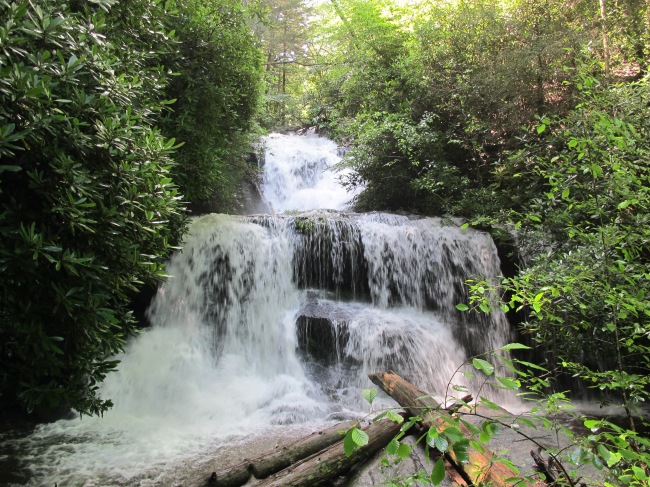
And now I can say I have seen Martin Creek Falls! Bartram wrote about the area while sitting at the base of this same waterfall in 1775.
With all the rain and storms this summer, there were obstacles.
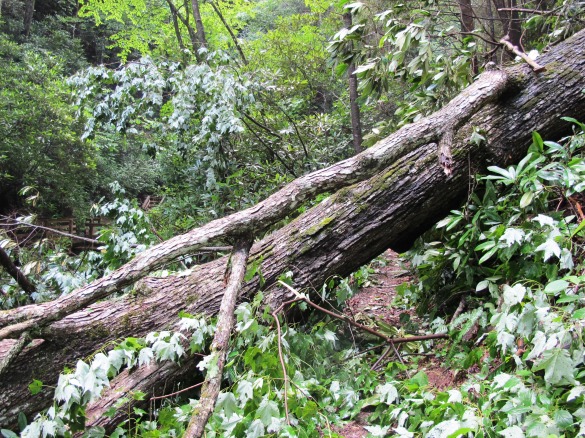
Lots of trail work ahead this fall.

Made for some interesting bushwacking, though.
I wanted to see where the trail continued, because it seemed to end at the falls and I thought someday I’d like to continue a longer run or hike past this section. I bushwacked around for awhile but found nothing. Then I re-traced my steps to the campground and found another spur trail up to the falls (marked with the same blaze, yellow diamonds). No continuation. Finally, I found that there was another trail (again, marked with the same Bartram Trail blaze) that was the actual continuation of the trail. I ran along this for awhile (when the inclines allowed oxygen intake) before deciding I needed to turn around, having given an ETA to my friends and not wanting to be late. [Of course I had my phone! But I didn’t have any service.]
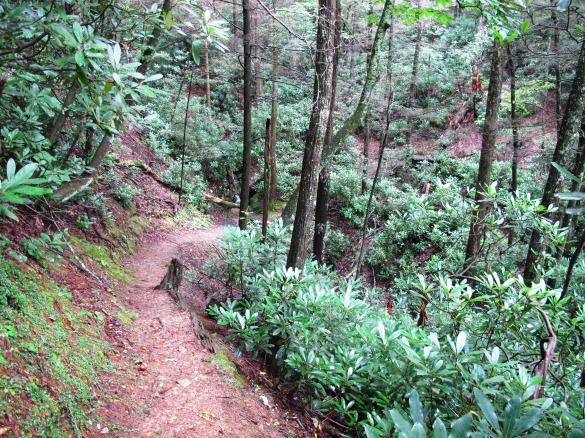
Yahooo! There were some fun descents along the way. This section was mostly runnable.
Section 2: Hale Ridge Road to Scaly Mountain (and back, about 11 mi RT that was actually 12+ with some additional route-finding)
Early on Sunday afternoon, I pulled myself away from the scourge of email and decided it was time to get out. A few bumpy miles down the dirt and gravel Hale Ridge Rd. and I was at the trailhead, the southernmost point of the NC Bartram Trail (in NC, the blaze is yellow rectangles). This point was about 17.7 miles from Warwoman Dell, so I skipped a 15 mile section in north GA that included Rabun Bald.
The first section, up to Highway 106, was fairly runnable. I had been wanting to do this section and see Hurrah Ridge. Who doesn’t want to explore side trails with names like Hurrah Ridge and Puc Puggy Trail? In the end, though, I had chosen Scaly Mountain as a destination, so I reluctantly left these intriguing trails for another day.

I ran through pine-oak-heath forest, with numerous ravines and mini waterfalls–awesomely scenic, when I took my eyes off the ground.

Fly poison, Amiathemum muscotoxicum. I didn’t say the name was beautiful.
I should have realized from the elevation profile that the 2 miles from NC 106 to the summit of Scaly Mountain would be tough, with a thousand feet of elevation gain. But I was looking for adventure, not speed, so I alternated climbing and hiking. This was a beautiful section of trail, through a gorgeous open montane oak forest with beautiful wildflowers, so I didn’t really mind taking it slow.
I also hiked for a bit with my two co-instructors, Julie and Alan, who were taking a more leisurely hike and photographs.
The next section was interesting. I’d describe it as Class 2 whitewater.

This is not a view of a creek off to the side of the trail. This *is* the trail.
We’d had 14 inches of rain in the area in the first six days of class, and as I neared the summit of Scaly Mountain, the water poured off the trail, well over ankle deep in many places. It was amazing. I passed a garter snake near the summit, then reached the summit of Scaly Mountain and paused to rest and enjoy the views.
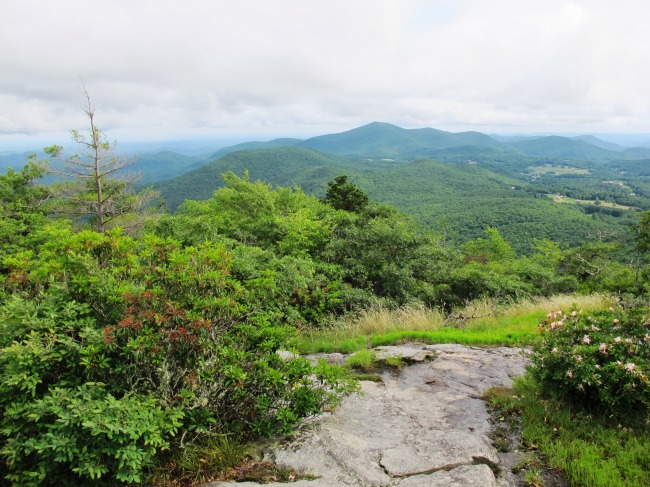
The reward of a steep climb. The peak in the distance is Rabun Bald, Georgia’s second-highest peak. Scaly Mountain, my vantage point, tops out just above 4500 feet. I started my run on the other side of the nearer peak. There is something satisfying about looking back where you came.
I scampered back down the trail, missing a switchback and ending up in somebody’s yard. Then I turned the wrong way when I got back on the trail, and was experiencing some serious doubt and déjà vu when I ran into a group of hikers coming toward me. A little sheepishly, I asked them if they were heading to the summit, or if they were heading down from the summit. They were heading down, the direction I *should* have been going. Drat. I turned around and made the switchback this time.
The rest of the run was pretty uneventful, but the extra mile or two of back-tracking made me glad to reach the car.

Extreme speed botany. I brought back a few branches for my friends and co-instructors. FYI, there’s no such thing as a gift of flowers or leaves to fellow botanists–it’s either a prank, a question, or an ID challenge.
I returned to the Highlands Biological Station and started cooking dinner with Julie and Alan. “How was your hike? Did you make it through the whitewater trail up to the Scaly summit?” “We went through the flooded section, but we were turned around before the summit by some fauna.” “A bear?” “Nope. Did you miss the timber rattler?” -PAUSE- “I didn’t see a timber rattler. I saw a garter snake. I mean, I’m certain it was a garter snake. Geez, I hope it was a garter snake!” We compared photos.

This is a garter snake. See his not-triangular head, cute stripes, and lack of rattles?

And *this* is a timber rattlesnake. Have to admit, he’s beautiful! But I didn’t see him. (Photo by Julie Tuttle)
Whew!
It was a great way to spend a day off in the mountains, and I hope to run more of the Bartram Trail on my next visit. These kinds of solo adventures fill my introvert’s need for a re-charge when life gets crazy.


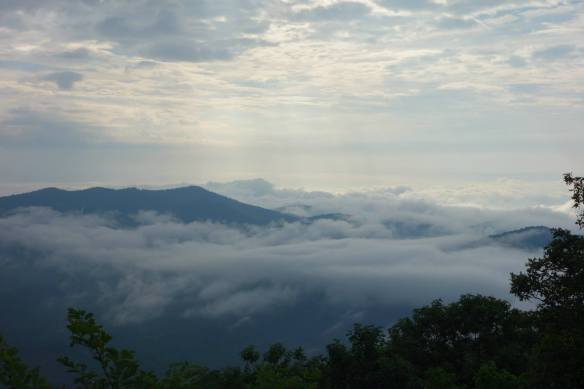




















 [I wrote the first draft of this poem on March 7, 2011, upon reading the news from the US Fish and Wildlife Service that the eastern cougar had been declared extinct. I’ve revised it off and on since then. This isn’t the final word–genetic evidence suggests that the Eastern cougar (Puma concolor couguar) was one variety of the North American cougar species. Yet, I felt a sense of personal loss–not as an ecologist, but as an ordinary citizen of my planet.]
[I wrote the first draft of this poem on March 7, 2011, upon reading the news from the US Fish and Wildlife Service that the eastern cougar had been declared extinct. I’ve revised it off and on since then. This isn’t the final word–genetic evidence suggests that the Eastern cougar (Puma concolor couguar) was one variety of the North American cougar species. Yet, I felt a sense of personal loss–not as an ecologist, but as an ordinary citizen of my planet.]